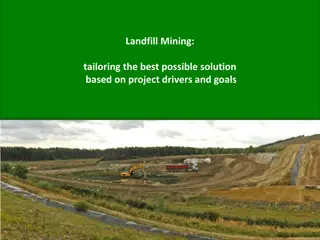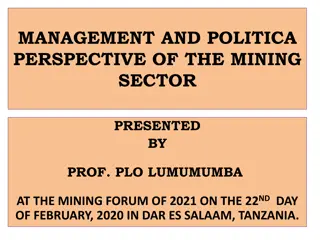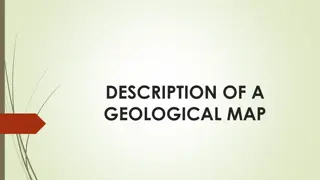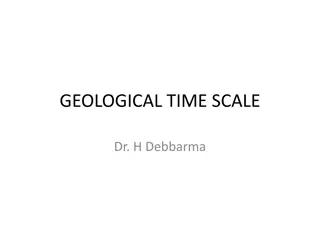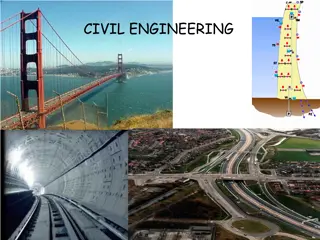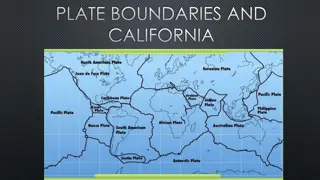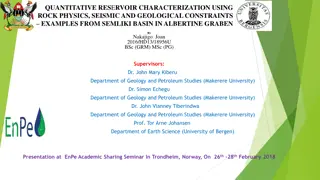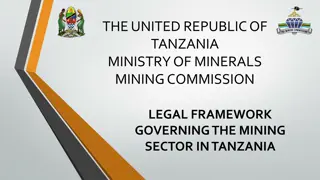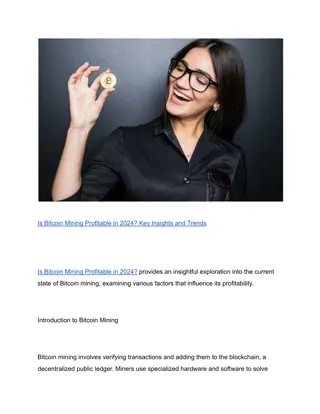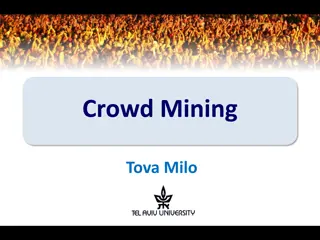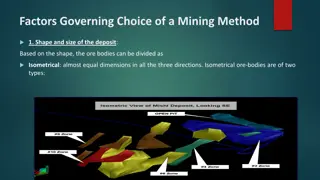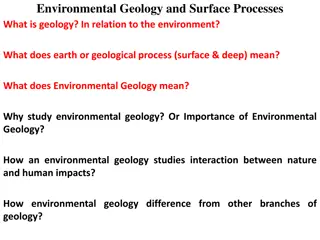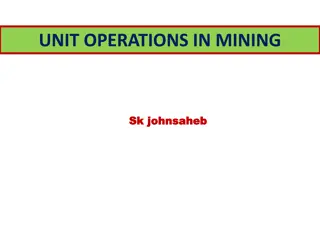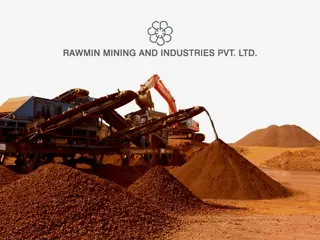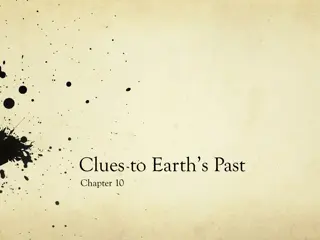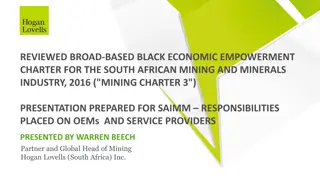Earth's Geological Processes and Environmental Impact of Mining
Earth's geological processes involve the formation and movement of tectonic plates, creating divergent and convergent boundaries, leading to events like earthquakes and volcanic eruptions. Gold mining, a process that extracts small amounts of gold from large quantities of rock using cyanide leaching, has significant environmental consequences, as seen in incidents like the 2000 contamination in Romania.
Download Presentation

Please find below an Image/Link to download the presentation.
The content on the website is provided AS IS for your information and personal use only. It may not be sold, licensed, or shared on other websites without obtaining consent from the author. Download presentation by click this link. If you encounter any issues during the download, it is possible that the publisher has removed the file from their server.
E N D
Presentation Transcript
Chapter 14 Geology and Nonrenewable Minerals
Core Case Study Environmental Effects of Gold Mining Gold Mining typically removes large quantities of rock to extract tiny amounts of gold. Cyanide Heap Leaching spraying of highly toxic cyanide salts (which react with gold) on large piles of rock, and catching the toxic runoff into storage ponds. The ponds are circulated a number of times and the gold is removed from the ponds. Extremely toxic to wildlife Romania suffered major water contamination in 2000 and in 2001, when snow and heavy rains washed out an earthen dam on one end of a cyanide leach pond.
Earths Major Geological Processes Primitive earth cooled into 3 major concentric zones. Core earth s inner most zone (solid inner part, surrounded by liquid core of molten rock) Mantle thick, solid rock zone surrounding the core ASTEHNOSPHERE hot partly melted rock that flows and can be deformed like soft plastic Crust outermost & thinnest zone. (continental crust & oceanic crust 71%) LITHOSPHERE outermost part of the mantle and continental crust oceanic crust.
Earths Major Geological Processes Convection cells or currents move large volumes of rock and heat in loops within the mantle like giant conveyer belts. Tectonic Plates huge rigid plates where much of earth s geologic activity takes place as they separate, collide or slide past one another When these plates move they produce tremendous forces that cause mountain ranges to form, earthquakes to shake parts of the crust, and volcanoes to erupt.
Earths Major Geological Processes Divergent Boundary when ocean plates move apart allowing molten material to flow up though the cracks creating oceanic ridges. Convergent Boundary - ocean plates collide with continental plates. The continental plate rides up over the cooler, denser, oceanic plate and pushes it down into the mantle by a process called subduction. Trenches ordinarily form here, but when two continental plates collide they form mountains along the collision boundary. Transform Fault continental or ocean plates slide past one another
Earths Major Geological Processes Some parts of earth build up, while others wear down. Internal geologic processesgenerated by the heat from the earth s interior, build up the earth s surface via continental and oceanic crust. External geologic processesare driven directly by or indirectly by the energy from the sun and include wind, flowing water, and glaciers which all contribute to erosion and are influenced by gravity. WEATHERING major external influence containing three types, Chemical, Biological, and Physical. It is the first step in soil formation.
Volcanoes Volcanoes are formed when magma reaches the surface via fissures. When the magma reaches the earth s surface it is then called lava. Volcanic activity can release debris ranging from large chunks of lava rock to glowing hot ash, liquid lava, and gases such as H2O vapor, CO2, and SO2. Most activity is concentrated around tectonic plate boundaries. Example: Ring of Fire Mount Pinatubo 1991 largest stratospheric disturbance in 20th century http://www.youtube.com/watch?v=K7NnLO5NNb8 Mount St. Helens 1980 worst in U.S. history http://www.youtube.com/watch?v=BaRAGzjSkzo
Volcanoes Volcanism produces scenic views and produces fertile soils formed by weathering of lava. This draws attention from humans as settlement locations. We can reduce human lives lost and property damage in these areas by the following: Use historical records and geologic measurements to prevent people from living in these areas. Monitor volcanic activity to warn of eruptions. Develop evacuation routes and plans for those who live in areas prone to volcanic activity.
Earthquakes Forces inside the earth s mantle cause rocks to suddenly shift or break producing transform faults or fractures in the crust. Abrupt movement causes energy to be released in the form of vibrations called seismic waves. These waves move through surrounding rock and this process is called an earthquake. Most occur at boundaries of tectonic plates.
Earthquakes Focus place where an earthquake begins below the earth s surface. Epicenter found directly above the focus on the earth s surface. Magnitude measure of ground motion indicated by the size of the seismic waves. Used to measure severity of an earthquake. Richter Scale used to measure earthquake intensity. Each unit has amplitude 10 times greater than the next smaller unit. Aftershocks/Foreshocks tremors after or before an earthquake
Earthquakes 1989 California Earthquake 1994 California Earthquake 2011 Japan Tsunami
Tsunamis Tsunami series of large waves generated when part of the ocean floor suddenly rises or drops. Tsunamis are caused by underwater earthquakes, volcanic eruption, or thrust faults in the ocean floor. Between 1900 and late 2007 tsunamis killed approximately 278,000 people in the Pacific Ocean region.
Tsunamis 2004 Tsunami
Landslides Gravity and earthquakes can cause landslides by detaching loose soil, rocks, and mud to slide down steep slopes. This movement is called mass wasting. Landslide Video French Alps Landslide
Earths Rocks and how Theyre Recycled. The earth s crust consists mostly of minerals and rocks. Minerals elements or inorganic compounds that occur naturally in the earth s crust as a solid and with a regular internal crystalline structure. Single element examples: Gold, Silver, and diamonds (carbon). Most of the more than 2000 identified minerals exist as inorganic compounds: Salt (NaCl) Quartzite (SiO2) Rocks solid combination of one or more minerals found in the earth s crust. Single mineral rocks: Limestone (CaCO3), Quartzite (SiO2) Two or more mineral rocks: Things like Granite which is made of feldspars, micas, and quartz crystals. (From Left to Right: Gold, Silver, Salt, Quartzite, Limestone, Granite)
Three Major Rock Types Sedimentary made of sediments- dead plant and animal remains and existing rocks that are eroded and weathered into tiny particles. Igneous - forms below the earth s surface when magma wells up from the earth s upper mantle or deep crust and then cools and hardens. Metamorphic forms when preexisting rock is subjected to high temperatures, high pressures, chemically active fluids, or a combination of these, which
cooling melting Weathering and Erosion Heat and Pressure SEDIMENTS melting Weathering and Erosion Compaction and cementation Weathering and Erosion Heat and Pressure
Mineral Resources and the Environmental Effects of Using Them Mineral Resource concentration of naturally occurring material from the earth s crust that can be extracted and processed into useful products and raw materials at an affordable cost. EXAMPLES: Fossil Fuels Coal Metallic Minerals Al, Fe, and Cu Nonmetallic Minerals Sand, Gravel, Limestone *Because they take so long to form, these components of the earth s natural capital are classified as NONRENEWABLE MINERAL RESOURCES.
Mineral Resources and the Environmental Effects of Using Them Ore rock that contains large concentrations of a particular mineral (often metal). High-grade Ore contains large amount of desired nonrenewable resource. Low-grade Ore contains small amount of desired nonrenewable resource.
Important Metals Aluminum packaging, structural material Steel alloy of Fe, and other elements such as Mn, Co, Mo, and Cr. Used in all types of products. Copper electrical and communications Platinum electronics, catalyst in industry, and in automobile pollution control converters Gold electrical equipment, jewelry, coins, medical implants, and as a catalyst to speed up certain chemical reactions
Important Nonmetals Most widely used nonmetals are sand and gravel. Sand is primarily SiO2 or silicon dioxide. It is used to make glass, bricks, and concrete. Gravel is used for roadbeds and to make concrete. Limestone is mostly CaCO3 or calcium carbonate. It is crushed to make road rock, concrete, and cement. Phosphate salts are mined and used in inorganic fertilizers and some detergents. Reserves identified resources from which the mineral can be extracted profitably at current prices
Mineral Use Advantages Mining and processing minerals does have benefits. Generates Significant income Provides Local, State, and National revenues from taxes, fees, and royalties. Provides Employment directly and indirectly
Mineral Use Disadvantages Use enormous amounts of energy Disturb Land Produce Solid Waste Pollute the Air, Water, and Soil The environmental impacts of mining an ore are affected by it s percent of metal content, or grade. Mining lower grade ores takes more money, energy, water, and other materials and increases land disruption, mining waste, and pollution. Why? Because lower grade ores are harder to extract and you need more volume of material to compare with the high percent of material available in high grade ores, which are easier to extract.
Mining Techniques Surface Mining used to harvest shallow deposits Subsurface Mining used to harvest deep deposits Open Pit Mining Machines dig massive holes and remove ores Strip Mining used for extracting deposits that lie close to the earth s surface and lie in horizontal beds. Area Strip Mining used where terrain is fairly flat Contour Strip Mining used where terrain is hilly or mountainous Mountaintop Removal use of explosives, large power shovels, and huge machines to remove tops of mountains Hydraulic Mining using water cannons to wash entire hillsides into collection boxes. (outlawed in U.S.)
Waste/Spoil Piles Mountain Top Removal Open Pit Mining Subsurface Mining
Mining Terms Overburden soil and rock overlying a useful mineral deposit. Spoils overburden discarded as waste material Tailings the unused materials left on land from dredging ore deposits from streams
Life Cycle of a Metal Resource Surface Mining Metal ore Separation of ore from gangue (waste material pronounced gang) Smelting Recycling Melting Metal Conversion to Product Discarding of Product
Natural Capital Degradation STEPS Mining Exploration, Extraction Environmental Effects Disturbed Land; mining accidents; health hazards; mine waste dumping; oil spills and blowouts; noise; ugliness; heat. Processing Transportation, Purification Manufacturing Solid wastes; radioactive material; air, water, and soil pollution; noise; safety and health hazards; ugliness; heat. Use Transportation or transmission to individual user, eventual use and discarding Noise; ugliness; thermal water pollution; pollution of air, water, and soil; solid and radioactive wastes; safety and health hazards; heat.
Mining Harmful Environmental Effects Scarring and Disruption of the Land Surface Destroys biodiversity Chemical Weathering and Erosion of spoils and tailings Production of Toxic waste water Production of large amounts of solid waste Clean up is Costly and mining areas may not be Subsidence collapse of land above underground mines Acid Mine Drainage rainwater seeping through a mine or mine waste pile carries H2SO4 into streams or groundwater.
Smelting Harmful Environmental Effects Emits enormous amounts of air pollutants and suspended particles Damage vegetation and acidify soils in the surrounding area Cause water pollution Produces toxic liquid and solid waste that requires safe disposal
Mineral Resources are Distributed Unevenly Some areas have rich mineral deposits while others have few or none. US imports 50% or more of 24 of its most important nonrenewable resources. Four Strategic Metal Resources include Manganese, Cobalt, Chromium, and Platinum which are essential for US economics and military strength. Nanomaterials may eventually be a substitute for some of these materials.
Nonrenewable Mineral Resources can be Economically Depleted Future Supply of Nonrenewable Minerals depends on the ACTUAL or POTENTIAL Supply and the RATE at which it is used. Minerals become Economically Depleted when it costs more than it is worth to find, extract, transport, and process the remaining deposits. At this point we can recycle or reuse, waste less, use less, find a substitute, or do without Depletion Time the time it takes to use up a certain portion of reserve at a given rate of use. Typically 80%.
Depletion Curves Curve A shortest depletion time Curve B longer depletion time Curve C longest depletion time
Economics and Mining Geological processes determine the quantity and location of a mineral resource. Economics determines what part is extracted and used. Standard economic theory states that in a competitive market a plentiful mineral resource is cheap when it s supply exceeds demand and when a resource becomes scarce it s price rises. Rising prices can help encourage exploration, develop better technology, promote resource conservation, search for substitutes, and make it profitable to mine lower-grade ores.
Economics and Mining Some Economists say this price effect may no longer occur in developed countries since Industry and government use subsidies, taxes, regulation, and import tariffs to control supplies, demands, and prices of minerals. An artificially low price helps to promote economic growth and national security. Most consumers are unaware of real costs being higher than the market price, since they are paying taxes that provide government subsidies and tax breaks to mining companies and to environmental effects of mining. Note: Between 1982 and 2007, U.S. Mining companies received more than $6 billion in government subsidies.
Economics and Mining Critics of Mining Add hidden extra costs to market prices so harmful environmental effects of mining will be drastically reduced, would increase recycling and reuse dramatically, and allow for many minerals to be replaced with less environmentally harmful substitutes. Mining Companies Need taxpayer subsidies and low taxes to keep the prices of minerals low for consumers. Subsidies also help keep companies local instead of taking their business to other countries where they will not face such high taxes and regulation.
U.S General Mining Law of 1872 Designed to encourage mineral exploration and the mining of hard- rock minerals such as Au, Ag, Cu, Zn, Ni, and U on public US lands to help develop the then sparsely populated West. Under this law claims could be made on US public lands, except National parks and wilderness, for $500 to improve for mineral development, and $120/year/20 acres whether or not mining is in operation. Until 1995 when a freeze on such land transfers was declared by Congress. However at that time, the price per hectare dropped to $6 - $12 or $2.50 -$5. per acre. Once land was transferred the transferee could then lease, build, sell, or use for essentially any purpose. According to a 2004 study $285 billion worth of publicly owned mineral resources have been transferred to private companies. 1/5 of them to foreign companies at 1872 giveaway prices.
U.S General Mining Law of 1872 Mining companies remove approximately $400 billion in hard rock minerals per year from U.S. Public Lands. Companies pay taxpayers 2.3% of mineral value compared to 13.2% for fossil fuels and 14% for grazing rights on public land. Companies have abandoned severely degraded and polluted mining sites leaving expensive clean up to the taxpayers. U.S. Department of the Interior estimates that the clean up of more than 500,000 abandoned sites will cost taxpayers approximately $32-72 billion.
The Politics Critics of Mining Mining Companies Have to invest large sums of money to develop a site before profits can be made Government subsidized land costs help provide high paying jobs for miners. Supply vital resources for Industry Stimulate economies Reduce trade deficits Keep mineral products affordable Money given up for subsidies offsets the lower prices Ban such public land sales or propose 20 year leases Stricter environmental controls and cleanup Set up fund paid for by royalties to clean up abandoned sites Mining companies would pay 8-12% royalty off of the gross income Canada, Australia, South Africa, and other countries require higher royalty payments and have laws that make mining companies fully responsible for environmental damage
Mining Lower-grade Ores In 1900 average copper ore mined was 5% copper by weight. Today it is 0.5%. New technologies are being developed to extract low-grade ores. Limitations to the mining of low-grade ores include increased cost of mining, the limited availability of freshwater, and the environmental impacts. In-place or in situ mining use of microorganisms to extract minerals. This process is referred as Biomining, which removes desired metals from ores while leaving the surrounding environment undisturbed. This process is extremely slow and can take decades to remove the same volume of material that conventional methods can remove in months or years.
Mining Minerals from the Ocean Some ocean minerals are dissolved in sea water. However, most are in very low concentrations which require more energy and money than they are worth. Only Mg, Br, and NaCl are abundant enough to be extracted profitably. Sediments along the continental shelf are significant sources of sand, gravel, phosphates, sulfur, tin, copper, iron, tungsten, silver, titanium, platinum, and diamond. Other sources include Hydrothermal Ore Deposits around thermal vents in which minerals precipitate out, and Manganese Nodules that litter the ocean floor of the Pacific. Problems with utilizing these sources fall to high costs, ownership, and environmental impacts on aquatic ecosystems.
Using Mineral Resources More Sustainably Materials Revolution elements like silicon and compounds like plastic and ceramic being substituted for metals. Examples include glass fiber optic cables for communications and Grancrete (styrofoam sprayed with ceramic)for building materials Use of Nanotechnology (molecular level engineering) Use of High-strength plastics and composite materials strengthened by lightweight carbon and glass fibers Why would using plastics still cause environmental issues? Chemists are learning how to make some plastics from plant materials Recycle and Reuse valuable metals (recycling aluminum produces 95% less air pollution and 97% less water pollution and uses 95% less energy than mining and processing it. Ask how can we decrease our use and waste of minerals opposed to how we can increase our supplies of nonrenewable minerals
Solutions Sustainable Use of Nonrenewable Minerals Do Not Waste Mineral Resources Recycle and Reuse 60-80% of mineral resources Include the harmful environmental costs of mining and processing minerals in the prices of items (full-cost pricing) Reduce mining subsidies Increase subsidies for recycling, reuse, and finding substitutes Redesign manufacturing processes to use less mineral resources and to produce less pollution and waste (cleaner production) Use mineral resource wastes of on manufacturing process as raw materials for other processes Slow population growth








